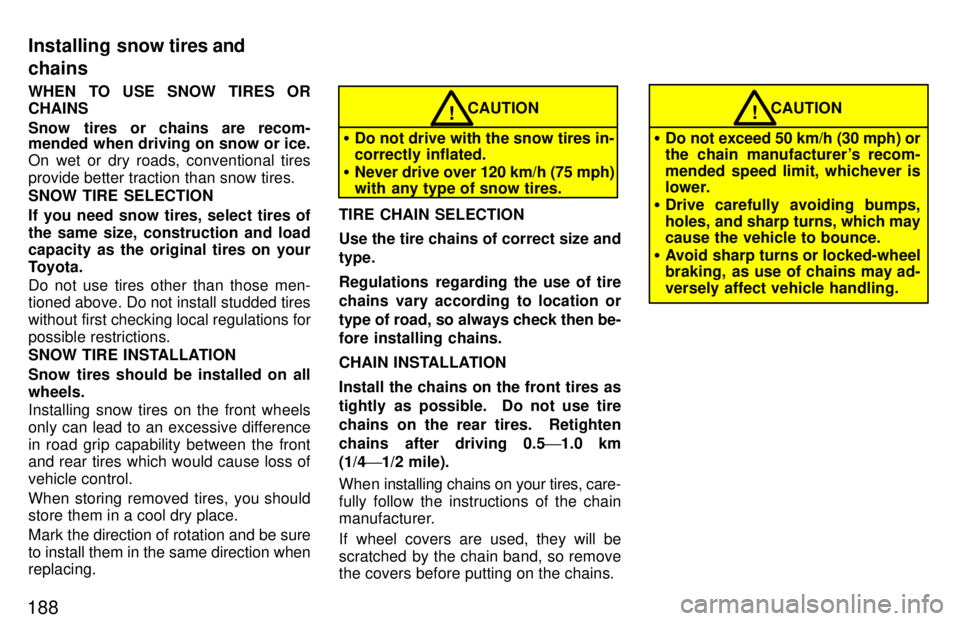Page 189 of 221

188WHEN TO USE SNOW TIRES OR CHAINS
Snow tires or chains are recom-
mended when driving on snow or ice.
On wet or dry roads, conventional tires
provide better traction than snow tires. SNOW TIRE SELECTION
If you need snow tires, select tires of
the same size, construction and load capacity as the original tires on your
Toyota.
Do not use tires other than those men-
tioned above. Do not install studded tires
without first checking local regulations for
possible restrictions.
SNOW TIRE INSTALLATION
Snow tires should be installed on all wheels. Installing snow tires on the front wheels
only can lead to an excessive difference
in road grip capability between the front
and rear tires which would cause loss of
vehicle control.
When storing removed tires, you should
store them in a cool dry place.
Mark the direction of rotation and be sure to install them in the same direction when replacing.
CAUTION
� Do not drive with the snow tires in- correctly inflated.
� Never drive over 120 km/h (75 mph)
with any type of snow tires.!
TIRE CHAIN SELECTION
Use the tire chains of correct size and type.
Regulations regarding the use of tire
chains vary according to location or
type of road, so always check then be-
fore installing chains.
CHAIN INSTALLATIONInstall the chains on the front tires as
tightly as possible. Do not use tire
chains on the rear tires. Retighten
chains after driving 0.5 '1.0 km
(1/4 '1/2 mile).
When installing chains on your tires, care- fully follow the instructions of the chain
manufacturer.
If wheel covers are used, they will be
scratched by the chain band, so remove the covers before putting on the chains.
� Do not exceed 50 km/h (30 mph) or
the chain manufacturer's recom-
mended speed limit, whichever is
lower.
� Drive carefully avoiding bumps,
holes, and sharp turns, which may cause the vehicle to bounce.
� Avoid sharp turns or locked-wheel
braking, as use of chains may ad- versely affect vehicle handling.
CAUTION!
Installing
snow tires and
chains
Page 190 of 221

189
WHEN TO REPLACE YOUR WHEELS
If you have wheel damage such as
bending, cracks or heavy corrosion,
the wheel should be replaced.
If you fail to replace damaged wheels, the
tire may slip off the wheel or they may cause loss of handling control. WHEEL SELECTION
When replacing wheels, care should
be taken to ensure that the wheels are
replaced by ones with the same load
capacity, diameter, rim width, and off-set.
Correct
replacement wheels are available
at your Toyota dealer.
A wheel of a different size or type may ad-
versely affect handling, wheel and bear-
ing life, brake cooling, speedometer/
odometer calibration, stopping ability,
headlight aim, bumper height, vehicle
ground clearance, and tire or snow chain clearance to the body and chassis. Replacement
with used wheels is not rec-
ommended as they may have been sub-jected to rough treatment or high mileage
and could fail without warning. Also, bent
wheels which have been straightened
may have structural damage and there-
fore should not be used. Never use an in-
ner tube in a leaking wheel which is de-
signed for a tubeless tire. �
After driving your vehicle the first 1600
km (1000 miles), check that the wheel
nuts are tight.
� If you have rotated, repaired, or
changed your tires, check that the
wheel nuts are still tight after driving
1600 km (1000 miles).
� When using tire chains, be careful not
to damage the aluminum wheels.
� Use only the Toyota wheel nuts and
wrench designed for your aluminumwheels.
� When balancing your wheels, use only
Toyota balance weights or equivalent
and a plastic or rubber hammer.
� As with any wheel, periodically checkyour aluminum wheels for damage. If
damaged, replace immediately.
Aluminum wheel precautions
Replacing wheels
Page 207 of 221

206
FOUR-WHEEL DRIVE MODELS
Model:
2RZ-FE, 3RZ-FE and 5VZ-FE
Type: 2RZ-FE and 3RZ-FE engine
4 cylinder in line, 4 cycle, gasoline
5VZ-FE engine 6 cylinder V type, 4 cycle, gasoline
Bore and stroke, mm (in.): 2RZ-FE engine
95.0 x 86.0 (3.74 x 3.39)
3RZ-FE engine
95.0 x 95.0 (3.74 x 3.74)
5VZ-FE engine 93.5 x 82.0 (3.68 x 3.23)
Displacement, cm 3
(cu. in.):
2RZ-FE engine 2438 (148.8)
3RZ-FE engine 2694 (164.3)
5VZ-FE engine
3378 (206.1)
Normal cab models Xtra-cab models
Overall length mm (in.) 4585 (180.5) 5055 (199.0)
Overall width mm (in.) 1690 (66.5) *1
1690 (66.5)
1720 (67.7) *2
1720 (67.7)*2
Overall height mm (in.) 1710 (67.3) *1,3
1700 (66.9)*1,3
1740 (68.5) *2,3
1735 (68.3)*2,3
Wheelbase mm (in.) 2625 (103.3) 3095 (121.9)
Front tread mm (in.) 1395 (54.9) *3
1460 (57.5)*4
1500 (59.1) *5
1500 (59.1)*5
Rear tread mm (in.) 1455 (57.3) *4
1455 (57.3)*4
1495 (58.9) *5
1495 (58.9)*5
Cargo weight rating kg (lb.) 500 (1100) 500 (1100) *6
317 (700) *7
*1 : With P225/75R 15 tires
*2 : With 31 x 10.5R 15 LT tires
*3 : Unladen vehicle
*4 : With steel wheels
*5 : With aluminum wheels
*6 : With 3 occupants
*7 : With 5 occupants
Engine
Page 212 of 221
211
Engine compartment (U.S.A.) Fuses (type A)
1. STOP 15 A: Stop lights, high-
mounted stoplight, cruise control sys- tem
2. ALT-S 7.5 A: Charging system
3. STA 7.5 A: Multiport fuel injction sys-
tem/sequential multiport fuel injection
system, starting system, gauges and meters
4. OBD 10 A: On-board diagnosis sys-
tem
5. EFI 15 A: Multiport fuel injection sys-
tem/sequential multiport fuel injection system
P195/75R14 200 (2.0, 29) 240 (2.4, 35) 14 x 5J
P215/70R14 200 (2.0, 29) 200 (2.0, 29) 14 x 6J
14 x 6JJ
P225/75R15 180 (1.8, 26) 200 (2.0, 29) 15 x 6J 15 x 7JJ
31x10.5R15LT 180 (1.8, 26) 200 (2.0, 29) 15 x 7JJ) Tire size
Tire pressure
kPa (kgf/cm 2
or bar, psi)
Front RearWheel size
Wheel nut torque, N
�m (kg �fm, ft �lbf):
110 (11.5, 83)
Tires
Fuses